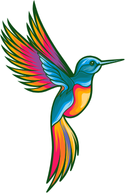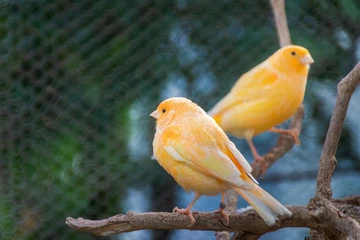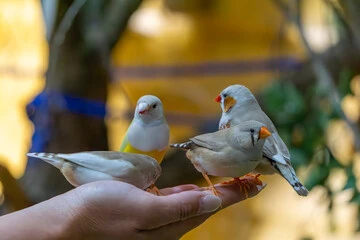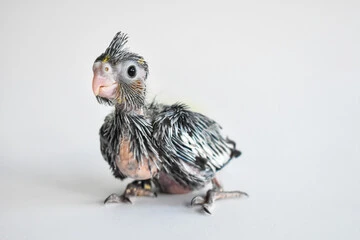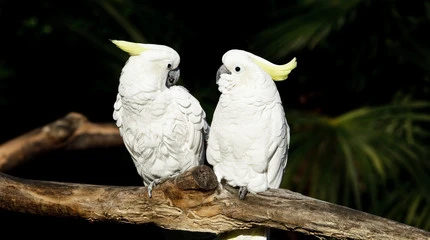Blue Colored Birds: Proven Happy Tips to Understand Their Charm
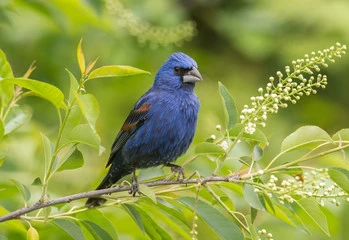
Have you ever paused during a morning walk, captivated by a flash of brilliant blue darting through the trees? That sudden glimpse of cerulean, azure, or sapphire against a green backdrop is a moment of pure magic. Blue colored birds have fascinated humans for centuries, symbolizing happiness, freedom, and the beauty of the natural world. But there’s more to these avian wonders than meets the eye. In this comprehensive guide, you’ll discover the stunning variety of blue bird species, the fascinating science behind their coloration, and how to identify them in the wild. Whether you’re an avid birder or simply a nature lover, prepare to see these magnificent creatures in a whole new light.
Table of Contents
The Science Behind Blue Feathers: Why Blue Birds Aren’t Actually Blue
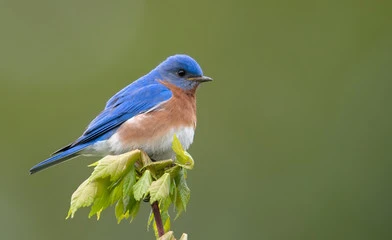
Here’s a mind-bending fact: blue colored birds aren’t truly blue in the way you might think. Unlike red or yellow feathers, which get their color from pigments, blue is a structural color. This means that the blue you see is created by the way light interacts with the feather’s structure.
How Structural Coloration Works
The feathers of blue birds contain tiny air pockets and protein molecules arranged in a way that scatters light. When light hits these structures, it refracts and reflects primarily blue wavelengths, while absorbing other colors. This phenomenon, known as Tyndall scattering, is the same reason the sky appears blue. If you were to crush a blue feather, the structure would be damaged, and the blue color would disappear—because there’s no blue pigment present.
This incredible adaptation means that the appearance of blue bird species can change depending on the lighting conditions. A Blue Jay might look vibrant blue in direct sunlight but almost gray on a cloudy day. This also explains why no bird can be truly “blue” in the way a banana is yellow—it’s all an illusion of light!
Types of Blue Birds: A Continent of Azure Wonders
North America is home to a diverse array of blue colored birds, each with unique characteristics and habitats. Let’s explore some of the most beloved species you might encounter.
Eastern Bluebird (Sialia sialis)
- Appearance: Males boast a vibrant royal blue on their back and head, with a warm reddish-brown chest. Females are grayer with subtle blue tinges.
- Habitat: Open fields, meadows, and areas with sparse trees.
- Behavior: Often seen perched on fences or wires, scanning for insects. They are cavity nesters and readily use nest boxes.
Blue Jay (Cyanocitta cristata)
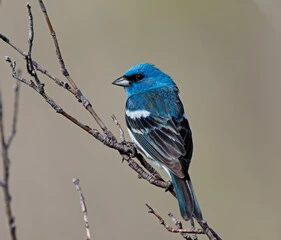
- Appearance: Striking blue plumage with white underparts and black markings on the face and neck. Known for their crest and loud, jay! jay! calls.
- Habitat: Forests, woodlands, parks, and suburban gardens.
- Behavior: Highly intelligent and sometimes aggressive, Blue Jays are known to mimic hawk calls and store food for later.
Indigo Bunting (Passerina cyanea)
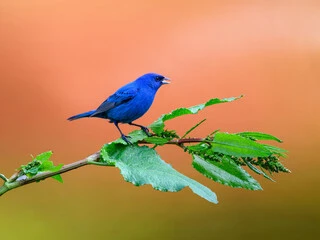
- Appearance: Breeding males are a breathtaking, solid deep blue all over. Non-breeding males and females are brown with hints of blue.
- Habitat: Brushy fields, forest edges, and along roadsides.
- Behavior: These small finches are often heard before they are seen, singing cheerful, paired notes from a high perch.
Mountain Bluebird (Sialia currucoides)
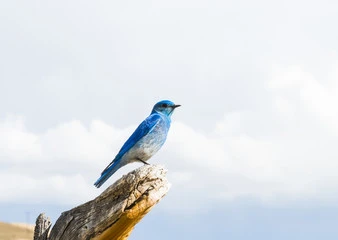
- Appearance: Males are a stunning sky-blue all over, lighter than the Eastern Bluebird. Females are gray-brown with blue wings and tail.
- Habitat: Open rangelands and mountain meadows in the West.
- Behavior: They hover over open ground before dropping to catch insects.
Western Bluebird (Sialia mexicana)
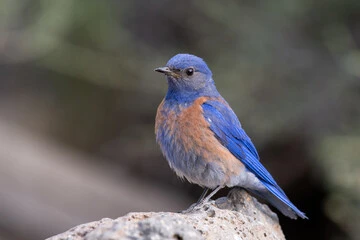
- Appearance: Similar to the Eastern Bluebird but with blue throat and more extensive red on the breast.
- Habitat: Open woodlands, particularly those affected by fire or logging.
- Behavior: Social birds, often seen in small flocks outside of the breeding season.
Blue Grosbeak (Passerina caerulea)

- Appearance: Large, stocky finch. Males are deep blue with rusty-colored wing bars and a massive silver bill.
- Habitat: Dense brush, streamside thickets, and woodland edges.
- Behavior: As related keyword sources note, these richly colored birds can raise two broods in a single season.
Table: Quick Guide to Common North American Blue Birds
| Bird Species | Male Coloration | Female Coloration | Size | Primary Region |
|---|---|---|---|---|
| Eastern Bluebird | Royal blue back, rusty chest | Gray with blue tinges | 6.5-8″ | East of Rockies |
| Blue Jay | Various blues with white & black | Same as male | 9-12″ | East and Central |
| Indigo Bunting | Solid deep blue | Brown | 4.5-5.5″ | East |
| Mountain Bluebird | Sky-blue overall | Gray-brown with blue wings | 6.5-8″ | West |
| Western Bluebird | Blue with red chest & blue throat | Dull gray with some blue | 6.5-7″ | West Coast |
| Blue Grosbeak | Deep blue with rusty bars | Cinnamon-brown | 6-7.5″ | South |
Beyond the Common: Rare and Exotic Blue Colored Birds
While the species above are widespread, the world of blue birds extends far beyond. Some, like the spectacular types of blue birds, include rare color mutations in parakeets. Other exotic global species include:
- The Hyacinth Macaw: The largest flying parrot, covered in stunning cobalt-blue feathers.
- The Common Kingfisher: A small, dazzling bird with bright blue and orange plumage, found across Europe and Asia.
- The Superb Fairywren: An Australian bird where the breeding male molts into an brilliant electric blue suit.
The Evolutionary Advantage of Being Blue
Why did birds evolve this complex structural trick to appear blue? Scientists propose several theories:
- Camouflage: In the right light, a blue bird can blend into the sky, hiding from predators below.
- Mate Attraction: Vibrant, structurally based colors are often a sign of health and good genes, making them a powerful signal in courtship. A brighter blue might indicate a stronger, more successful mate.
- Species Recognition: Distinctive colors help birds identify members of their own species from a distance.
Capturing the Beauty: Tips for Blue Bird Photos
Photographing these birds can be challenging due to their shifting colors. Here’s how to get the best blue bird photos:
- Lighting is Everything: Shoot with the sun behind you to illuminate the feathers and maximize the blue refraction.
- Use a Fast Shutter Speed: These birds are often quick and flighty. A shutter speed of 1/1000th of a second or faster can freeze their motion.
- Patience and a Telephoto Lens: A good zoom lens (300mm+) allows you to capture detail from a distance without disturbing them.
- Focus on the Eye: As with all wildlife photography, a sharp eye creates a compelling image.
Frequently Asked Questions About Blue Colored Birds
Q: Are there any birds with true blue pigment?
A: No. While some birds have blue skin (like the Cassowary), no known bird species has blue pigment in its feathers. All blue feather coloration is structural.
Q: What was the small, solid blue bird I saw? It had no orange chest.
A: You likely saw an Indigo Bunting! As noted in competitive descriptions, a finch-sized, solid blue bird with no orange chest is a classic identifier for a male Indigo Bunting during breeding season.
Q: How can I attract blue birds to my yard?
A: It depends on the species! Eastern and Western Bluebirds are attracted to nest boxes and mealworms. Blue Jays love peanuts and sunflower seeds.
Q: Is a blue jay really blue?
A: Technically, no. Their feathers are brown but contain air pockets that act as a prism, refracting light to create the illusion of blue. This is true for all structurally blue birds.
Q: Are blue birds related to each other?
A: Not necessarily. Blue coloration has evolved independently in many different bird families, from thrushes (bluebirds) to corvids (jays) to finches (buntings). It’s a stunning example of convergent evolution.
Conclusion: A World of Blue Wonders Awaits You
The world of blue colored birds is a testament to nature’s incredible ingenuity. From the scientific marvel of structural coloration to the diverse array of species that wear this “color of the sky,” there is always more to learn and appreciate. These birds bring a splash of magic to our backyards and wild spaces, reminding us of the beauty and complexity of the natural world.
We hope this guide has inspired you to look closer the next time a flash of blue catches your eye. Grab your binoculars, your camera, or simply your sense of wonder, and head outdoors. The symphony in blue is waiting for you.
What do you think? Have you been lucky enough to spot a brilliant Indigo Bunting or host a family of Bluebirds? Share your experiences and favorite blue bird photos in the comments below! And if you found this guide helpful, please share it with fellow bird lovers on social media.
